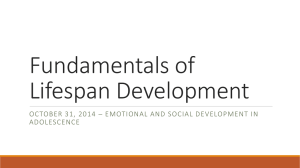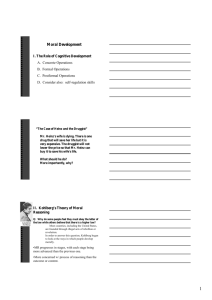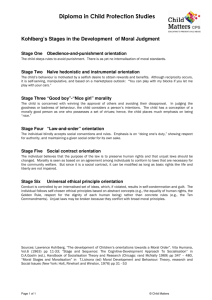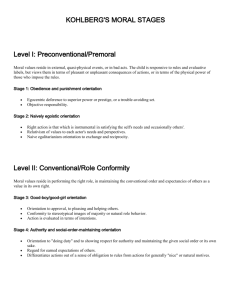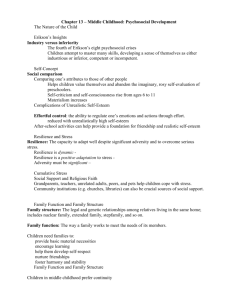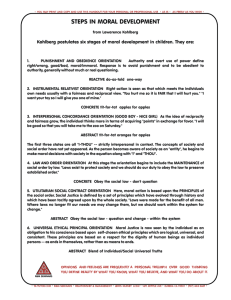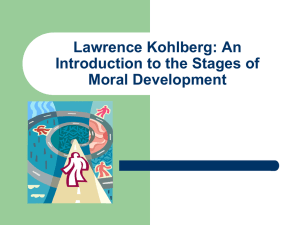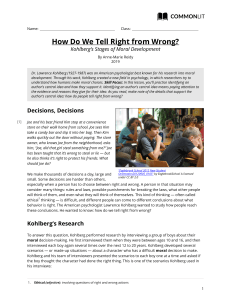March 19 – Social and Personality Development in
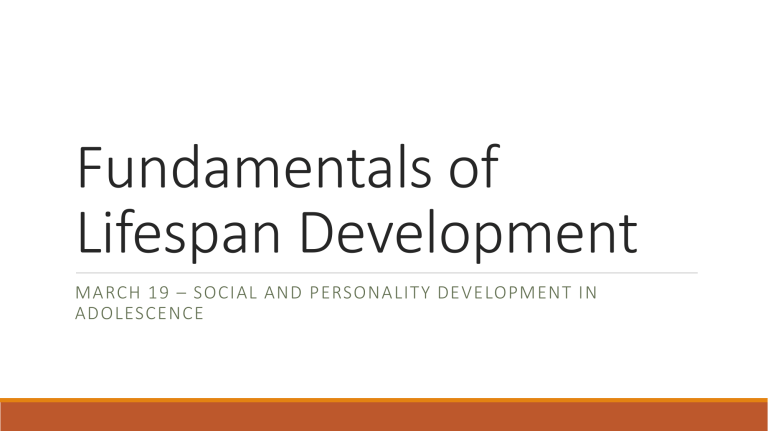
Fundamentals of
Lifespan Development
MARCH 19 – SOCIAL AND PERSONALITY DEVELOPMENT IN
ADOLESCENCE
Video
Defining your Identity – Ted Talk
Identity in the 21 st century – Ted Talk
Erikson – Identity vs Role Confusion
Identity
Defining who you are, what you value, and your direction in life
Commitments to vocation, relationships, sexual orientation, ethnic group, ideals
Exploration, resolution of “identity crisis”
Role Confusion
Lack of direction and self-definition
Earlier psychosocial conflicts not resolved
Society restricts choices
Unprepared for challenges of adulthood
Paths to Identity
Identity Status and Cognitive Style
Factors Affecting Identity
Personality
Child-rearing practices:
◦ attachment
Peers, friends
Schools, communities
Culture
Societal forces
Self-Understanding & Self-Esteem
Kohlberg’s Theory of Moral Development
Moral Questions
The Quebec government is cutting funding to public services because it claims that there is no more money in the budget for these services (austerity budgets)
At the same time, our governments are giving money to corporations and banks (our tax money!)
The students of a variety of departments at Concordia have passed strike votes via their general assemblies to protest against austerity
Starting Monday, many of these students will be on strike at Concordia
Many of these students will form picket lines and block classes from taking place
Students are demanding that the Quebec government to abandon it’s austerity budget and reinvest in the public sector
Do you think students are justified in performing acts of civil disobedience to initiate positive social change?
Kohlberg’s Stages of Moral Development
Kohlberg’s Theory of Moral Development
Preconventional Level
Stage 1 – The punishment and obedience orientation
◦ Relies on physical consequences to determine right or wrong
◦ Difficult to consider two points of view. Overlook people’s intentions.
Stage 2 – The individualism, instrumental purpose and exchange orientation
◦ Seek reward / avoid punishment (naïve hedonism)
◦ People can have different perspectives. Right action follows from self interest. Reciprocity as equal exchange.
Kohlberg’s Theory of Moral Development
Conventional Level
Stage 3 – Mutual interpersonal expectations, relationships, and interpersonal conformity orientation (a.k.a. good boy/girl orientation)
◦ Desire to obey rules because they promote social harmony. Seeks approval.
◦ Makes judgements based on intention of behaviour
Stage 4 – The social system and conscience orientation (a.k.a. law and order orientation)
◦ Individuals take into consideration larger perspective of societal laws.
Kohlberg’s Theory of Moral Development
Postconventional Level
Stage 5 – The social contract orientation
◦ Rules and laws are flexible instruments for furthering human purpose. Can imagine alternative forms of social order. Emphasize fair procedures for interpreting and changing laws.
Stage 6 – The universal ethical principal orientation
◦ Self-chosen ethical principles of conscience that are valid for all people regardless of laws and social agreement.
Kohlberg’s Theory
Morality
Follow up Research on Kohlberg’s Theory
◦ Few people reach postconventional morality
◦ Stages 3 and 4 reflect morally mature reasoning
◦ In real life, people often reason below actual capacity
Critique of Kohlberg’s Theory
◦ Western culture bias
◦ Does not consider justice and care
◦ Behaviour does not always math moral reasoning
Influences on Moral Reasoning
Role taking
Cognitive development
Child-rearing practices:
◦ caring, supportive
◦ discussions of moral concerns
Schooling: higher education
Peer interaction
Culture
Relationship with Family and Peers
Parent-Child Relationship
Sibling Relationship
Friendships
Cliques and Crowds
Romantic Partners
Self-Disclosure
Problems with Development
Delinquency
Early-onset: behavior begins in childhood:
◦ biological risks and inept parenting combine
◦ linked to serious antisocial activity
Late-onset: behavior begins around puberty
◦ peer influences
Pathway to Chronic Delinquency

